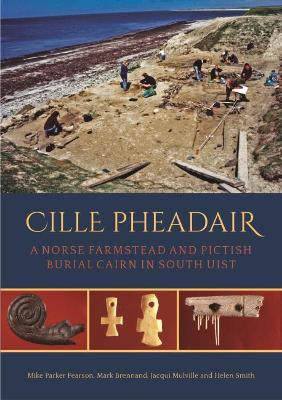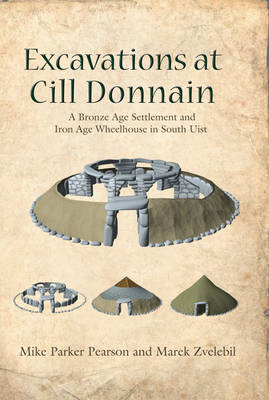Sheffield Environmental and Archaeological Research Campaign in the Hebrides
3 primary works
Book 7
Cille Pheadair
by Mike Parker Pearson, Mark Brennand, Jacqui Mulville, and Helen Smith
Published 26 July 2018
Cille Pheadair is one of more than 20 Viking Age and Late Norse settlements discovered on the island of South Uist in the Outer Hebrides (Western Isles), off the west coast of Scotland. Its unusually well-preserved stratigraphic sequence of nine phases of occupation, including five longhouses and many smaller buildings, provides a remarkable insight into daily life on a Norse farmstead during two centuries of near-continuous occupation c. AD 1000 –1200. Although the excavation at Cille Pheadair was a rescue project undertaken before the site was destroyed by coastal erosion, it provided an opportunity to address important research questions about the domestic use of space, agricultural economy, and relationships with the wider world beyond the Outer Hebrides. Careful and ground-breaking analysis of preserved house floors provided profound insights into the changing use of space within a Norse longhouse and its surrounding outbuildings. The rich assemblage of pottery, ironwork, gold and silver reveals that the inhabitants of Cille Pheadair had long-distance connections across the Viking world. A battery of scientific studies, including faunal and floral analyses, isotopic and lipid residue analyses, and soil chemistry, have revealed much about the social and economic dimensions of life on a Norse farm. Detailed survey and excavation in South Uist, reveals a remarkable picture of Norse-period settlement across this island which was part of the insular Viking world between Ireland and Norway, becoming part of the Kingdom of Man and later the Kingdom of the Isles. Cille Pheadair’s status as an ordinary, if wealthy, farmstead can be contrasted with the much larger and longer-lived high-status settlement at Bornais to the north. The two sites together provide a fascinating insight into similarities and differences within the settlement hierarchy of the time that makes a significant contribution to our understanding of the Viking world.
Book 8
Cladh Hallan
by Mike Parker Pearson, Jacqui Mulville, Helen Smith, and Peter Marshall
Published 15 August 2021
This first of two volumes presents the archaeological evidence of a long sequence of settlement and funerary activity from the Beaker period (Early Bronze Age c. 2000 BC) to the Early Iron Age (c. 500 BC) at the unusually long-occupied site of Cladh Hallan on South Uist in the Western Isles of Scotland. Particular highlights of its sequence are a cremation burial ground and pyre site of the 18th-16th centuries BC and a row of three Late Bronze Age sunken-floored roundhouses constructed in the 10th century BC. Beneath these roundhouses, four inhumation graves contained skeletons, two of which were remains of composite collections of body parts with evidence for post-mortem soft tissue preservation prior to burial. They have proved to be the first evidence for mummification in Bronze Age Britain.
Cladh Hallan's remarkable stratigraphic sequence, preserved in the machair sand of South Uist, includes a unique 500-year sequence of roundhouse life in Late Bronze Age and Iron Age Britain. One of the most important results of the excavation has come from intensive environmental and micro-debris sampling of house floors and outdoor areas to recover patterns of discard and to interpret the spatial use of 15 domestic interiors from the Late Bronze Age to the Early Iron Age. From Cladh Hallan's roundhouse floors we gain intimate insights into how daily life was organized within the house - where people cooked, ate, worked and slept. Such evidence rarely survives from prehistoric houses in Britain or Europe, and the results make a profound contribution to long-running debates about the sunwise organisation of roundhouse activities. Activity at Cladh Hallan ended with the construction and abandonment of two unusual double-roundhouses in the Early Iron Age. One appears to have been a smokery and steam room, and the other was used for metalworking.
Cladh Hallan's remarkable stratigraphic sequence, preserved in the machair sand of South Uist, includes a unique 500-year sequence of roundhouse life in Late Bronze Age and Iron Age Britain. One of the most important results of the excavation has come from intensive environmental and micro-debris sampling of house floors and outdoor areas to recover patterns of discard and to interpret the spatial use of 15 domestic interiors from the Late Bronze Age to the Early Iron Age. From Cladh Hallan's roundhouse floors we gain intimate insights into how daily life was organized within the house - where people cooked, ate, worked and slept. Such evidence rarely survives from prehistoric houses in Britain or Europe, and the results make a profound contribution to long-running debates about the sunwise organisation of roundhouse activities. Activity at Cladh Hallan ended with the construction and abandonment of two unusual double-roundhouses in the Early Iron Age. One appears to have been a smokery and steam room, and the other was used for metalworking.
Book 9
The SEARCH (Sheffield Environmental and Archaeological Research Campaign in the Hebrides) project began in 1987 and covers the Scotland’s Outer Hebrides. The aim of the project is to investigate how human societies adapted in the long-term to the isolated environment of the Outer Hebrides.
The first major excavation on South Uist discovered that what was thought to be a shell midden at Cill Donnain was in fact a wheelhouse, a type of dwelling used in the period c.300 BC – AD 500; under which lay the remains of a Bronze Age settlement. This settlement was partly investigated by Marik Zvelebil in 1991 and then later by Mike Parker Pearson and Kate MacDonald in 2003. The site itself is situated at the foot of a high steep-sided dune on the eastern edge of a large sand valley, close to the western shore of Loch Cill Donnain.
The archaeological report of the excavation at the Cill Donnain wheelhouse shows that, in comparison with contemporary neighbouring settlements, it was unlikely that each was an independent unit and that they were linked by social and economic inter-dependency. The wheelhouse thus provides striking new evidence that contributes to developing theories about the social, material and economic life in the period.
This volume presents the extensive archaeological evidence found at the site, including pottery, faunal remains and a variety of bone and metal tools, illustrating that the Cill Donnain landscape is rich in archaeological sites of all periods from the Beaker to the post-Medieval.
The first major excavation on South Uist discovered that what was thought to be a shell midden at Cill Donnain was in fact a wheelhouse, a type of dwelling used in the period c.300 BC – AD 500; under which lay the remains of a Bronze Age settlement. This settlement was partly investigated by Marik Zvelebil in 1991 and then later by Mike Parker Pearson and Kate MacDonald in 2003. The site itself is situated at the foot of a high steep-sided dune on the eastern edge of a large sand valley, close to the western shore of Loch Cill Donnain.
The archaeological report of the excavation at the Cill Donnain wheelhouse shows that, in comparison with contemporary neighbouring settlements, it was unlikely that each was an independent unit and that they were linked by social and economic inter-dependency. The wheelhouse thus provides striking new evidence that contributes to developing theories about the social, material and economic life in the period.
This volume presents the extensive archaeological evidence found at the site, including pottery, faunal remains and a variety of bone and metal tools, illustrating that the Cill Donnain landscape is rich in archaeological sites of all periods from the Beaker to the post-Medieval.


